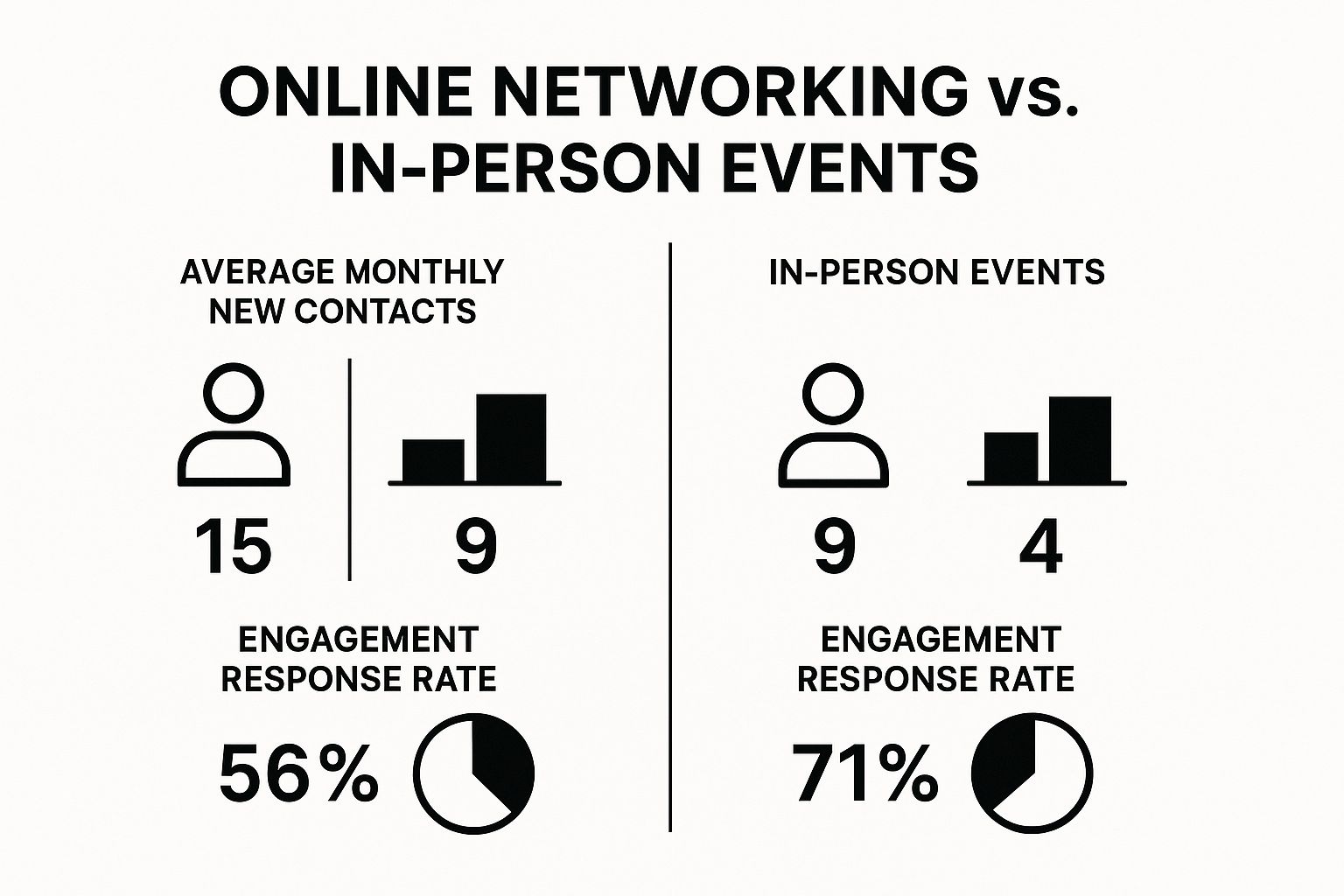Why Personal Branding Matters Now More Than Ever

Resumes and handshakes were once the cornerstones of professional introductions. Today, they're simply not enough. In our current professional world, a compelling personal brand is essential. It's not about boasting, but strategically showcasing your unique value in a world saturated with information.
Your personal brand is your amplified professional reputation. It’s the lasting impression you create, the expertise you share, and the meaningful connections you build. This carefully crafted narrative shapes perceptions and influences your opportunities.
Trust is the currency of today's marketplace, and personal branding is how you earn it. People are far more likely to trust a recommendation from someone they feel connected to than a generic advertisement. Nielsen reports that 92% of people trust recommendations from individuals, even strangers, over brand endorsements.
This emphasizes the power of authentic connection. Since Tom Peters introduced the concept of personal branding in his 1997 Fast Company article The Brand Called You, its importance has grown exponentially. This growth is especially evident on platforms like LinkedIn, where 89% of B2B professionals connect for career advancement. This demonstrates how personal branding directly impacts professional trust and opens doors to new possibilities. For a deeper dive into the statistics surrounding personal branding, check out this resource: Personal Branding Statistics.
The Tangible Benefits of a Strong Personal Brand
Beyond the buzz, a strong personal brand translates to tangible career benefits. It positions you as a thought leader in your field, attracting potential employers, clients, and collaborators. It also unlocks unforeseen opportunities, like speaking engagements and exciting collaborations you may never have imagined.
In a crowded marketplace, a strong personal brand makes you stand out. It clarifies your unique value proposition, making you a desirable prospect. It's a spotlight that highlights your skills and passions, making it easy for others to recognize your distinct value. This is especially crucial in competitive job markets.
Debunking Personal Branding Myths
Many believe personal branding is only for influencers or celebrities. This couldn't be further from the truth. While influencers utilize personal branding, its power extends to every professional. Whether you're an engineer, a teacher, or a marketer, a personal brand helps you articulate your strengths and connect with the right people.
Building a personal brand is not about creating a false persona. It’s about strategically showcasing your authentic self. It’s about identifying your strengths, passions, and experiences and presenting them in a way that resonates with your audience. Ultimately, creating a personal brand is about showcasing your best self to forge genuine and impactful connections. This authenticity builds the trust essential for success in today’s world.
Crafting Your Authentic Brand Identity

Creating a personal brand isn't about reinventing yourself. It's about strategically showcasing the amazing qualities you already possess. It's about identifying your core values and sharing your unique perspective with the world. Think of it as polishing a gem to reveal its inherent brilliance. This section will guide you through practical exercises to define your authentic brand identity.
Unveiling Your Value Proposition
Your value proposition is the special blend of skills, experiences, and perspectives you bring to the table. It's the answer to the question: "What makes you the ideal choice?" This isn't about bragging, but clearly articulating the value you provide.
Start by identifying your key strengths and the problems you solve exceptionally well. Are you a gifted communicator who can inspire and motivate? A creative problem-solver who thrives on challenges? Or perhaps a meticulous data analyst who uncovers hidden insights?
Looking for inspiration? Explore these personal brand strategy examples to see how others have successfully built their brands. Reflect on your own background and experiences. How have they shaped your unique perspective? This combination of skills and perspective forms the foundation of your authentic brand identity.
Conducting a Personal SWOT Analysis
A SWOT analysis (Strengths, Weaknesses, Opportunities, and Threats) is a powerful tool for self-discovery. Instead of generic lists, focus on insights that reveal your distinctive strengths and potential for growth within your chosen field. Be honest with yourself about where you excel and where you could improve.
List your core strengths, acknowledging areas where you might need further development. Then, identify opportunities aligned with your strengths and the current market demands. These opportunities could include emerging trends, niche markets, or skill gaps you can fill.
Consider potential challenges, such as increasing competition or evolving industry standards. This honest assessment helps you build a resilient and impactful personal brand, preparing you to navigate your professional journey effectively.
Defining Your Brand Mission
Your brand mission is a concise statement that captures your purpose and the value you deliver to your audience. It’s the guiding star for your personal brand. To create your mission, consider your core values, your target audience, and the impact you want to make.
Your mission should resonate with your audience while staying true to who you are. It's about finding that perfect balance between what you offer and what your audience needs. This clarity of purpose provides a strong foundation for all your personal branding efforts, ensuring your actions and messages consistently reflect your authentic self.
To help you define your personal brand elements, use the following worksheet:
A structured approach is essential for building a strong personal brand. The following table helps organize your thoughts and define your brand elements effectively.
Personal Brand Elements Worksheet
A structured approach to identifying the core elements of your personal brand
| Brand Element | Questions to Ask Yourself | Your Response | Examples |
|---|---|---|---|
| Core Values | What principles guide my actions and decisions? | Integrity, Creativity, Collaboration | |
| Unique Skills | What am I exceptionally good at? What problems do I solve? | Communication, Problem-solving, Data Analysis | |
| Target Audience | Who am I trying to reach? What are their needs and aspirations? | Aspiring entrepreneurs, Marketing professionals | |
| Brand Voice | How do I communicate? What tone and style best represent my personality? | Inspirational, Informative, Humorous | |
| Brand Message | What is the key takeaway I want people to remember about me? | Empowering others to achieve their full potential |
By completing this worksheet, you gain a deeper understanding of your personal brand and can use these insights to guide your actions and create a consistent brand experience. Remember, building a personal brand is a journey, not a destination. Embrace the process and allow your authentic self to shine.
Developing Your Visual Brand Language

Your visual brand language silently communicates your personal brand's essence before you even say a word. It's the visual identity that sets the tone for your online presence, much like a carefully chosen outfit makes a lasting first impression. Cultivating intentional visuals builds trust and recognition with your audience. Let's explore how to craft a visual identity that amplifies your personal brand.
Photography That Speaks to Your Audience
High-quality, professional photography is essential for a compelling personal brand. Your photos should capture your authentic self while projecting a professional image. A genuine smile and approachable posture in your headshot can foster immediate connection.
Authenticity doesn't mean compromising professionalism. Avoid blurry selfies and distracting backgrounds. Invest in photos that reflect your brand's core message. Consider the image you want to project: are you aiming for approachable and friendly, or focused and authoritative?
The Power of Color in Branding
Color psychology significantly influences how your brand is perceived. Your signature color palette should align with your brand values and resonate with your target audience. For instance, blue often represents trust and stability, while green symbolizes growth and innovation.
A cohesive color palette across your online platforms creates visual harmony, allowing your audience to instantly recognize your content. This consistency is particularly valuable on platforms like LinkedIn, where consistent branding reinforces your professional image.
Cohesive Templates for Streamlined Content
Designing cohesive templates for your social media graphics and presentations saves valuable time and ensures visual consistency. Imagine having pre-designed templates for your LinkedIn posts or Instagram stories. These templates maintain a unified aesthetic, making your content instantly recognizable.
Consistency shouldn’t stifle creativity. View your templates as a foundation, providing flexibility within a defined framework. This balance allows you to maintain a professional image while tailoring content to different platforms.
Balancing Consistency and Creativity Across Platforms
Visual consistency across platforms is paramount for building brand recognition. Using similar fonts, colors, and imagery across LinkedIn, Twitter, and your website strengthens your brand's visual identity. This consistent visual language reinforces your message and makes your brand easily identifiable.
While maintaining a cohesive look, infuse your personality into each platform. You might use a slightly more informal tone on Instagram than on LinkedIn, creating a relatable brand experience without sacrificing professionalism.
DIY Design vs. Professional Expertise
Creating a visual brand can be a DIY endeavor, particularly with the abundance of user-friendly design tools. However, collaborating with a professional designer offers advantages like tailored branding and a refined aesthetic. A professional can develop a cohesive and strategic visual identity that effectively communicates your brand message.
Consider your budget and the complexity of your branding needs. If you opt for DIY, prioritize simplicity and consistency. If you engage a designer, clearly articulate your vision and brand values. Regardless of your approach, a strong visual brand language amplifies your impact and distinguishes you in a competitive market.
Becoming the Go-To Authority Through Content

The infographic above illustrates the power of online networking compared to in-person events for personal brand building. It compares average monthly new contacts and engagement response rates. While in-person events might offer higher engagement, online networking dramatically expands your reach. You're able to connect with significantly more people monthly. This broader reach is essential for establishing authority and amplifying your brand’s impact. Content creation is key to unlocking this potential. It’s where your brand comes alive and your expertise shines.
Identifying Your Content Pillars
What specialized knowledge do you offer? Content pillars are the fundamental topics defining your expertise. These should be subjects you’re both passionate about and deeply knowledgeable in. They form the bedrock of your content strategy. By focusing on these pillars, you provide consistent, valuable insights within your niche.
For example, a marketing consultant specializing in social media might choose content pillars like social media advertising, content marketing, and community building. Focusing on these core areas attracts an audience genuinely interested in your specific skills.
Creating Content That Solves Problems
Your content should do more than just showcase your skills; it needs to solve real problems for your audience. Consider their challenges and how your knowledge offers solutions. This audience-focused approach cultivates trust and positions you as a go-to resource.
Offer practical tips, insightful analysis, and actionable strategies to address audience pain points. This solidifies your credibility and builds a loyal following. It’s the foundation for becoming a recognized authority.
Developing a Consistent Content Creation Workflow
Consistency is crucial for building a strong personal brand through content. But sticking to a regular posting schedule can be tough. Creating a manageable workflow is essential for long-term success.
A content calendar is invaluable for planning and scheduling your content. It lets you create a backlog of posts, easing the pressure to constantly create. Experiment with various content formats, like blog posts, videos, and podcasts, to find what resonates with your audience and suits your style.
Finding Your Unique Voice and Perspective
In the crowded content landscape, a unique voice is your differentiator. When exploring personal branding, developing a distinctive perspective is essential. It's not just about social media; it's about establishing authority. The 2025 Personal Branding Benchmark Report reveals that 78% of respondents haven't used podcasts or webinars, and 87% aren't utilizing video, missing valuable opportunities to build authority. Learn more about building a personal brand here.
Don’t shy away from infusing your personality into your content. Share personal stories, offer unique opinions, and experiment with your style. This deeper connection builds trust and loyalty. It establishes you as a distinct voice worth following, strengthening your brand, increasing engagement, and transforming you into a sought-after expert.
To help illustrate the effectiveness of different content formats, let's look at the following comparison:
Content Format Effectiveness Comparison: Analysis of different content formats for personal brand building
| Content Format | Engagement Level | Time Investment | Authority Building Potential | Best Platforms |
|---|---|---|---|---|
| Blog Posts | Medium | Medium | High | Personal Website, LinkedIn, Medium |
| Videos | High | High | Very High | YouTube, LinkedIn, Instagram, TikTok |
| Podcasts | Medium | Medium | Medium | Apple Podcasts, Spotify, Google Podcasts |
| Webinars | High | High | High | Zoom, Google Meet, Dedicated Webinar Platforms |
| Social Media Posts | Variable | Low | Medium | Platform Dependent (LinkedIn, Twitter, etc.) |
This table highlights the strengths and weaknesses of each format. While videos offer high engagement and authority-building potential, they require a significant time investment. Blog posts offer a balance between engagement, time investment, and authority building. Choosing the right mix of formats is key to maximizing your impact.
By understanding the nuances of each content format and leveraging the right platforms, you can effectively connect with your target audience, build a strong personal brand, and establish yourself as a true authority in your field.
Mastering Platform-Specific Strategies
Building a personal brand isn't about being everywhere; it's about being effective where it matters. Just as a skilled artisan selects the perfect tool, you must choose the platforms that align with your goals and resonate with your target audience. Platform-hopping dilutes your efforts and hinders momentum. A focused approach yields significantly better results than a scattered online presence.
Choosing the Right Platforms For Your Brand
Not all platforms are created equal. LinkedIn reigns supreme for professional networking, while Instagram excels in visual storytelling. Twitter thrives on real-time conversations, whereas platforms like TikTok or YouTube might be better suited for showcasing specific skills through video.
Consider your target audience: where do they spend their time online? If you're targeting business professionals, LinkedIn is essential. If you're a visual artist, Instagram or Pinterest might be more impactful. Aligning your platform strategy with your audience's online behavior is crucial for connection.
Optimizing Your Profiles For Impact
Your profile is your digital first impression. It should instantly communicate your value proposition and draw people in. Use a professional headshot and craft a compelling bio that highlights your expertise and unique perspective.
On LinkedIn, use keywords relevant to your industry to enhance searchability. On Instagram, use a visually appealing profile picture and a bio that captures your brand's essence. Optimizing each profile maximizes your visibility and ensures a positive first impression.
Creating Native Content That Resonates
Each platform has its own unique culture and content preferences. What works on LinkedIn might not work on TikTok. Respecting these nuances is key to building genuine engagement. To effectively communicate your message, consider learning more about crafting impactful prompts via prompt engineering.
On LinkedIn, share insightful articles and engage in industry discussions. On Instagram, use high-quality visuals and captivating captions. On Twitter, participate in relevant conversations and share concise, impactful updates. Creating native content demonstrates platform understanding and fosters deeper audience connections.
Building Genuine Engagement, Not Vanity Metrics
While follower counts and likes can be gratifying, genuine engagement is the true measure of success. Focus on building meaningful connections through thoughtful comments, insightful responses, and authentic interactions.
Ask questions, respond to comments, and participate in relevant discussions. This builds community and fosters loyalty, positioning you as a valuable resource.
Strategic Content Repurposing For Maximum Reach
Creating fresh content for every platform can be time-consuming. Content repurposing allows you to maximize your reach efficiently. A blog post can be transformed into LinkedIn posts, Instagram captions, or even short videos.
Maintain quality during repurposing. Simply copying and pasting content across platforms can feel impersonal. Tailor your message to suit each platform's format and audience. This strategic approach ensures your content remains engaging and relevant across various channels.
Learning From The Experts: Platform-Specific Excellence
Many professionals have achieved remarkable success by focusing on specific platforms. Study their strategies and observe how they tailor their content and interactions. This provides valuable insights for crafting your own approach. By mastering platform-specific strategies, you'll build a stronger brand, cultivate deeper connections, and unlock new opportunities.
Building Your Network of Brand Advocates
Your personal brand isn't built on follower counts. True strength comes from genuine connections, much like a mighty oak whose stability is rooted in its intricate network below. This section explores how successful professionals cultivate a network of brand advocates – individuals who actively champion their work and unlock exciting new opportunities.
Networking With Authenticity
Networking shouldn't feel like a transaction. It's about forging real relationships built on mutual respect and shared passions. Approach each interaction as a chance to learn and connect, not simply to gather contacts. Authenticity is crucial. People can sense insincerity. Focus on building relationships grounded in genuine interest and shared values.
Instead of constantly pitching your services at networking events, prioritize meaningful conversations. Ask questions, listen intently, and find common ground. This approach fosters trust and lays the foundation for enduring connections.
Connecting With Industry Leaders
Connecting with those you admire can feel intimidating. However, many industry leaders are more approachable than you think. Engage with their online content, offer thoughtful comments, and contribute to discussions they participate in. This demonstrates genuine interest and can initiate a connection.
Consider attending industry events or conferences where they might be speaking. These events offer opportunities for brief but memorable interactions. Building rapport takes time. Focus on making a genuine connection rather than seeking immediate favors.
Cultivating Digital Connections
Platforms like LinkedIn offer powerful networking opportunities. Join relevant groups, participate in discussions, and share valuable insights. This positions you as a thought leader and attracts like-minded professionals.
Online interactions should be just as authentic as in-person ones. Avoid generic comments and instead provide thoughtful contributions that add value to the conversation. This encourages genuine engagement and builds meaningful connections.
Turning Contacts Into Advocates
A strong network isn't about quantity, it's about quality. Brand advocates are those who actively promote your work, refer opportunities, and offer valuable feedback. How do you turn casual contacts into true advocates? By consistently nurturing your network and providing value.
Share relevant content, offer helpful advice, and celebrate their successes. These small gestures build goodwill and strengthen your connections, transforming casual contacts into staunch supporters.
Networking Strategies For Introverts
Traditional networking can be overwhelming for introverts. However, building a strong network remains essential. Focus on smaller, more intimate gatherings or one-on-one interactions. These settings often facilitate deeper conversations and more meaningful connections.
Online platforms can be invaluable tools for introverts. They provide a comfortable environment for engaging in discussions and building relationships at your own pace. Remember, networking is about building genuine connections, not putting on a performance.
Nurturing Your Network Authentically
Building a robust network requires ongoing effort. Implement a system for staying in touch, such as scheduling regular check-ins or sending personalized messages. Avoid generic outreach. Focus on offering value.
Share relevant articles, congratulate them on achievements, or simply ask how they’re doing. These small gestures demonstrate genuine interest and strengthen your connections over time. Building a network of brand advocates is a marathon, not a sprint. Consistent, authentic effort yields long-term rewards. By nurturing these relationships, you cultivate a powerful support system that propels your personal brand forward.
Evolving Your Brand As You Grow
Building a personal brand isn't a one-time endeavor. It's a continuous journey of growth and adaptation. Just as you evolve professionally and personally, your brand should too. This exploration focuses on keeping your personal brand aligned with your journey, ensuring it stays a powerful asset throughout your career.
Measuring the True Impact of Your Brand
Metrics like follower count and engagement rates offer a glimpse into your brand’s reach, but they only scratch the surface. True impact goes beyond vanity metrics. Consider how your brand influences your career path, opens doors to new opportunities, and shapes your reputation in your industry.
Are you attracting the right clients or collaborators? Are you being recognized as a thought leader in your niche? Are you receiving valuable feedback that fuels your growth? These qualitative indicators provide deeper insights into your brand’s effectiveness.
Gathering Meaningful Feedback
Actively seek feedback from your network, mentors, and even your audience. Ask specific questions about how they perceive your brand, what aspects resonate with them, and where they see room for improvement.
This feedback offers invaluable perspective and helps refine your brand messaging and online presence. Embrace constructive criticism and see it as a catalyst for growth.
Identifying When Pivots Are Necessary
Significant career changes or shifts in your focus might require a brand pivot. Perhaps you're transitioning to a new industry or expanding your expertise. These changes necessitate adjustments to your brand narrative and online presence.
Recognize when your brand no longer accurately reflects your professional identity. Be willing to adapt and refine your messaging to align with your evolving objectives.
Making Strategic Adjustments While Maintaining Trust
Evolving your brand requires careful consideration. While adaptation is essential, preserving the trust you've built with your audience is paramount. Communicate any significant shifts in your brand messaging clearly and explain the reasoning behind these changes.
Transparency builds trust and reinforces your authenticity. By openly addressing any brand pivots, you maintain credibility and strengthen the connection with your audience.
Handling Challenging Situations
Negative feedback or unexpected career transitions can present challenges to your personal brand. Address negative feedback constructively and view it as an opportunity to learn and grow. When facing career shifts, frame your story authentically and highlight the transferable skills and experiences you bring to your new role.
Maintaining composure and professionalism during challenging times reinforces your credibility and strengthens your reputation.
Brand Auditing and Refinement
Regularly audit your online presence to ensure your brand remains consistent and relevant. Review your website, social media profiles, and content to identify areas for improvement. Does your visual branding still align with your current identity? Is your content resonating with your target audience?
Brand refinement is an ongoing process. By consistently assessing and adjusting your online presence, you ensure your personal brand remains a powerful asset throughout your evolving career.
Are you ready to take charge of your personal brand and create a compelling online presence? Visit Henri Den for expert guidance and resources to help you build a brand that authentically represents you.





